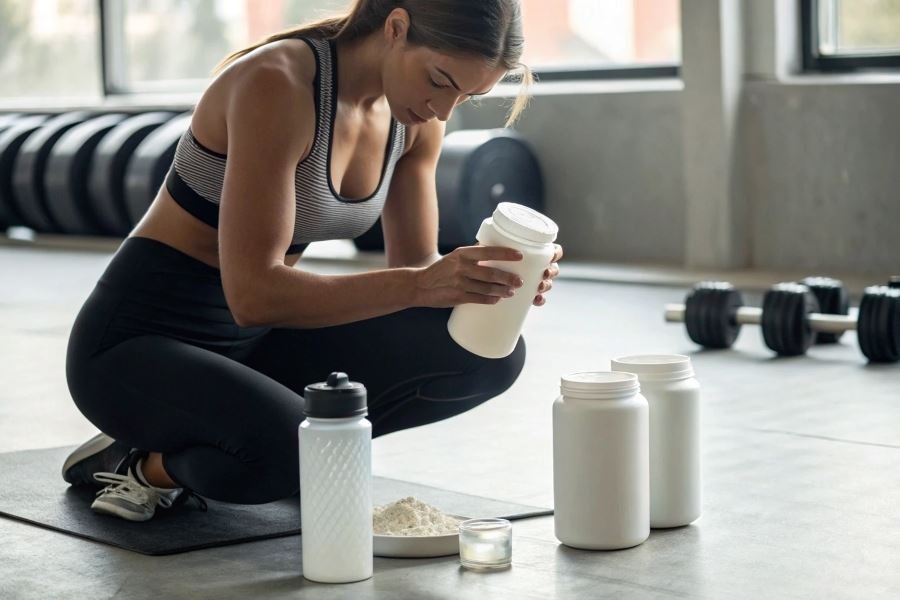
Did you know that female athletes metabolize protein differently than their male counterparts? This biological reality isn’t just a scientific footnote—it’s a game-changer for women seeking peak athletic performance.
When we talk about what amino acids women need in sports, we’re addressing a sophisticated biological equation. Female athletes face unique physiological challenges: hormonal fluctuations, different muscle-to-fat ratios, and distinct recovery patterns. These differences aren’t limitations—they’re opportunities for targeted nutritional strategies.
The female body’s relationship with amino acids is fascinating. Research from Stanford University shows women typically utilize leucine—a crucial branched-chain amino acid (BCAA)—more efficiently during endurance activities. Meanwhile, estrogen levels influence how effectively women synthesize protein, creating windows of opportunity throughout monthly cycles when supplementation can be particularly effective.
“Female athletes aren’t simply smaller versions of male athletes. Their bodies process nutrients through distinctly different pathways,” explains Dr. Maria Gonzalez, sports nutrition specialist.
The science reveals that women particularly benefit from lysine and arginine for collagen production (critical for joint health), while glutamine supports immune function during intense training periods. Female athletes also show enhanced recovery when supplementing with tryptophan, which helps regulate sleep and mood—factors that significantly impact training consistency.
Your body speaks a unique biochemical language. Understanding the amino acids that translate to female athletic excellence isn’t just smart nutrition—it’s your competitive advantage.
Essential Amino Acids for Female Athletes
When you’re pushing your limits on the track, in the gym, or on the field, your body’s nutritional needs become incredibly specific. For women in sports, understanding what amino acids do women need in sports can be the difference between good performance and great performance. These protein building blocks aren’t just supplements—they’re the foundation of athletic recovery, strength development, and hormonal balance that female athletes particularly benefit from.
BCAAs: The Recovery Powerhouse Trio
Branched-chain amino acids (BCAAs)—leucine, isoleucine, and valine—are the superstars of the amino acid world for female athletes. What makes them special? Unlike other amino acids, BCAAs bypass liver processing and head straight to muscle tissue.
Leucine stands out as the primary muscle-building trigger, activating the mTOR pathway that signals your body to build new muscle tissue. Women typically have lower muscle mass than men, making leucine particularly valuable for maintaining strength-to-weight ratios.
Research shows female athletes may need up to 2-3g of leucine post-workout to maximize muscle protein synthesis, compared to the standard recommendation of 1-2g.
Isoleucine and valine work alongside leucine to reduce exercise-induced muscle damage and decrease recovery time—crucial for women who often train multiple disciplines or have compressed training schedules.
| BCAA | Primary Benefit for Female Athletes | Recommended Daily Intake |
|---|---|---|
| Leucine | Muscle protein synthesis | 2-3g |
| Isoleucine | Glucose regulation and energy | 1-1.5g |
| Valine | Tissue repair and nitrogen balance | 1-1.5g |
Glutamine: The Immune System Guardian
Female athletes face unique immune challenges, with research suggesting that intense training can temporarily suppress immune function more significantly in women than men. Glutamine becomes your invisible shield during these vulnerable periods.
As the most abundant amino acid in the body, glutamine fuels immune cells and helps maintain gut barrier function—where much of your immune system resides. For female athletes balancing high-intensity training with career and family demands, glutamine supplementation (typically 5-10g daily) can help prevent the performance-destroying cycle of training hard → getting sick → losing training time.
During particularly intense training blocks, female athletes report fewer upper respiratory infections when supplementing with glutamine compared to placebo groups.
Arginine and Lysine: The Hormonal Harmony Duo
Female athletic performance is intimately connected to hormonal health, making arginine and lysine particularly valuable for women in sports.
Arginine serves as a precursor to nitric oxide, improving blood flow to working muscles and enhancing oxygen delivery. This becomes especially important during different phases of the menstrual cycle when hemoglobin levels naturally fluctuate. Beyond performance, arginine supports collagen synthesis—critical for joint health in female athletes who statistically face higher rates of certain joint injuries.
Lysine works synergistically with arginine while also supporting calcium absorption and hormone production. This amino acid helps regulate cortisol levels, which tend to spike higher in female athletes during intense training. By maintaining this delicate balance, lysine helps prevent the cascade of stress-related performance issues from disrupted sleep to compromised recovery.
The strategic combination of these key amino acids creates a foundation for female athletes to train consistently, recover efficiently, and perform at their peak across training cycles and competitive seasons.
Fueling Female Performance: Your Amino Acid Playbook
When it comes to athletic performance, amino acids are the unsung heroes powering every sprint, lift, and recovery session. For women athletes, understanding how to strategically use these building blocks can be a game-changer. Let’s dive into the practical side of amino acid supplementation that can elevate your training to new heights.
Timing is everything
The window for amino acid supplementation isn’t just open—it’s strategic. For maximum muscle protein synthesis, consuming 3-5 grams of leucine-rich BCAAs (branched-chain amino acids) 30 minutes before training primes your muscles for work. During longer sessions (60+ minutes), sipping on 5-10 grams of BCAAs can help maintain muscle integrity and delay fatigue.
The post-workout golden hour remains crucial—aim for 20-25 grams of complete protein containing all essential amino acids within 45 minutes after training. This timing isn’t arbitrary; it’s when your muscles are most receptive to nutrients that facilitate repair.
Performance tip: For morning training sessions, consuming 10-15 grams of EAAs (essential amino acids) before breakfast can counteract overnight catabolism without the fullness of a complete meal.
For women specifically, research suggests that estrogen levels may influence protein metabolism, potentially requiring slightly different timing strategies throughout the menstrual cycle—with potentially higher protein needs during the luteal phase.
Nature’s amino acids vs lab-created supplements
While supplements offer convenience, whole foods provide amino acids packaged with complementary nutrients that enhance absorption and utilization.
| Food Source | Complete Protein? | Notable Amino Acids | Serving Size |
|---|---|---|---|
| Greek yogurt | Yes | Leucine, isoleucine | 1 cup (25g protein) |
| Eggs | Yes | All EAAs, high in leucine | 2 large (12g protein) |
| Quinoa | Yes (rare for plants) | Lysine | 1 cup cooked (8g protein) |
| Salmon | Yes | Leucine, lysine | 4 oz (25g protein) |
| Lentils + rice | Yes (when combined) | Complementary EAAs | 1 cup each (18g protein) |
Supplements shine in specific scenarios: when whole food isn’t practical (immediately post-workout), when targeting specific amino acid ratios (like 2:1:1 leucine:isoleucine:valine for recovery), or when caloric restrictions limit food volume.
Quality matters tremendously. Third-party tested supplements from reputable manufacturers ensure you’re getting what’s on the label without contaminants—critical for competitive athletes subject to testing.
Your training, your amino acid strategy
The one-size-fits-all approach fails when it comes to amino acid supplementation. Your needs vary dramatically based on:
-
Training intensity: High-intensity interval training may benefit from higher leucine intake (4-5g) to combat muscle breakdown, while endurance athletes might focus on BCAAs during longer sessions to delay central fatigue.
-
Body composition goals: Women looking to maintain muscle while reducing body fat might increase protein intake to 1.8-2.2g per kg of bodyweight, with strategic EAA supplementation between meals.
-
Recovery demands: Two-a-day training sessions call for aggressive amino acid strategies, including intra-workout BCAAs and potentially bedtime casein protein to support overnight recovery.
For strength athletes, prioritize leucine-rich supplements and foods. Endurance athletes should consider adding tryptophan and tyrosine to their amino acid profile to support neurotransmitter production during long sessions.
The most effective approach combines baseline recommendations with personal experimentation. Track your recovery metrics, performance outcomes, and subjective feelings to fine-tune your amino acid strategy into a powerful tool that supports your unique athletic journey.
